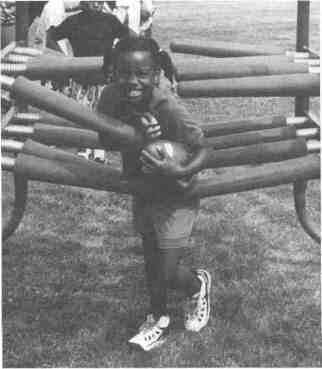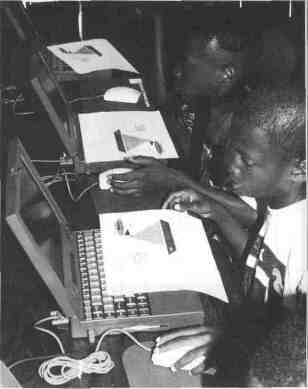PARTNERSHIPS
PARK DISTRICTS, FOREST PRESERVES AND RECREATION DEPARTMENTS
WORKING TOGETHER WITH CIVIC AND BUSINESS LEADERS TO BUILD OUR COMMUNITIES
Camp Kid Fitt for Kids' Sake
Seed money sprouts an ongoing cooperative
program for disadvantaged youth
BY WILLIAM L. CLEVENGER,CLP AND
KAREN E. BENJAMIN,CLP
|

|
"The rise in juvenile violence has had a devastating effect on our kids.
A recent Justice Department study found that the prime time that this
violence occurs is between 3 p.m. and 6 p.m. After meeting with the
Illinois Association of Park Districts, my staff could think of no better way
to spend this settlement than in the areas where at-risk youth will benefit from innovative programs offering positive options."
Illinois Attorney General Jim Ryan
In November of 1995, Attorney General Jim Ryan distributed
$380,000 in grants to seven Illinois park districts. The funds came
from a national legal settlement with Reebok International Ltd., the
shoe manufacturer. In Illinois the Attorney General was responsible
for distributing the local portion of the settlement. Soon after, programs were in place in Carbondale, Chicago, Decatur,Joliet, Kankakee
Valley, Peoria and Waukegan park districts.
Decatur's funds were used for Camp Kid Fitt, an eight-week program coordinated by the park district with the assistance of many
local organizations. This cooperative venture concentrated on sports,
computer skills, drug prevention awareness, leadership development,
self-esteem and nonviolent conflict resolution. Community role models
were also part of the program, providing a vehicle for campers and
staff to interact with a variety of community partnerships. The Camp
Kid Pitt experience eventually culminated with a reception given by
campers for Attorney General Jim Ryan, where they presented him
with a mural they had created in camp.
|
Between 60 and 100 children ages 8 to 13 participated each day,
July/August 1997 /9
boarding vans at three sites. Homework Hangout, a local initiative to
improve students' grades and educational opportunities was one site.
Another was Longview Housing Project, housing hundreds of families through Decatur Housing Authority. The third van stop was
Coppenburger School, a Project Success school promoting Governor
Edgar's efforts to house services for families under one roof.
Two trained staff with backgrounds as athletes and coaches staffed the camp, along with other part-time help (typically recreation or
education majors in their last year of college). Other enrichment by
staff came to the campers through a unique blending of relationships
between numerous agencies and corporations.
Listed below are activities coordinated by camp staff:
Exploration of facilities in Fairview Park, learning camp rules and expectations
Tour of Decatur Police Department, including squad cars, finger printing, etc.
Police K-9 officer demonstration
Camp Olympics with prizes donated by local merchants
Daily lunch and snacks provided through Illinois State Board of Education
A week of activities at Richland Community College (drawing classes, computer skills classes, ceramics, throwing day pots on a wheel, nutritionist presentations,talent show preparation, and construction of a mural for Attorney General Jim Ryan)
Fishing programs with Illinois Department of Natural Resources
Tae kwon do with World Tae Kwon Do Academy
Swimming at Fairview Pool
Presentations on drug prevention awareness from Motivation, sponsored by
Decatur Housing Authority and Decatur Mental Health Center
Decatur Athletic Banquet with featured speaker Julius Irving
Ice cream donated by Dairy Queen
Conflict resolution exercises with counselors from Decatur Housing Authority
Fun Day with Eldorado Bowl and Godfather's Pizza
Rope skipping program, sponsored by American Heart Association
Chess instruction with master chess player, Danny Humphrey
Scovill Zoo (Project Playground visit, train ride, petting zoo and exhibit visits,
lunch in the park)
Swimming at Nelson Pool, followed by lunch at McDonalds
Bowling and making spaghetti
Trips to the movies for good behavior
Basketball camp with coaches and athletes from Millikin University
Football camp with coaches from Millikin University
Millikin University Mini Olympics
Life choices seminar with Millikin coaches
Radio station visit (campers spoke "on the air" with Millikin University President McCray)
Millikin tour of dorms, science laboratories, library, etc.
Talent show and deejay at Millikin University
Tennis instruction at Fairview Tennis Complex with Chuck Kuehl, local pro
from Decatur Athletic Club
Soccer in Fairview Park
Baseball game, Busch Stadium
Junior Prom, semiformal attire, professionally baked snacks and cake from a
local bakery
Chips and Pepsi for trips, provided by Decatur Housing Authority
Visit to Decatur Celebration to meet Chicago Bears and to pose for photos
The seed money provided for a successful first season of Camp Kid
Fitt and has created the basis for development of another venture for
youths during the summer of 1997. Decatur Park District will interface with the Decatur Housing Authority to provide a slightly different version of Camp Kid Fitt, a partnership utilizing HUD funding
and Decatur Park District staff, facilities and other support.
WILLIAM L. CLEVENGER
is the executive director of the Decatur Park District.
KAREN E. BENJAMIN, CLP
is the director of recreation tor the Decatur Park District.
|

|
Why the Partnership Worked
The parties involvedfrom campers to staff to sponsors-did what they were supposed to do in a timely manner. This
occurred because ample funding was available, which ensured accountability in planning, supervision, direction and evaluation of Camp Kid Fitt.
The partnership was a cooperative effort among many agencies and sponsors who were accustomed to working with
one another. This set the tone to roll lots of opportunities
together, creating a groundwork where campers, parents, staff
and sponsors could shine.
Commitment on the part of local, regional and state entities placed a high benchmark of expectations on everyone involved. "Youths and adults involved rose to the challenge. We
aim very high when planning any program. People will eventually do what you expect them to do.
We ascribe to the "NIKE THEORY," both campers and
staff "just do it," and this saves everyone a lot of rime. Participants and their mentors thrived on the discipline that Camp Kid Fitt provided.
Keren E. Benjamin, CV
|
10/ Illinois Parks and Recreation
YOUTH VIOLENCE FACTS
In a 1996 poll of Illinois households, education and crime were cited as the most important problems facing the state, and 62 percent
of the survey respondents said that they think
violent crime is on the rise. Twelve percent of
the survey respondents indicated that they or
a member of their immediate family had been
the victim of a violent crime in the past three
years. Illinois Policy Survey, Northern Illinois University
Between 1985 and 1995, Illinois' violent crime
rate jumped 37 percent. While Chicago's violent crime rate increased 29 percent during the
time period, violent crime more than doubled
in suburban areas and more than tripled in
rural areas of the state. Illinois Criminal
Justice Information Authority (ICJLA)
Estimates suggest that the annual monetary
cost of violent crime in Illinois exceeds $2.7
billion. When quality of life is factored in the
cost exceeds $15.6 billion, enough to send
nearly 200,000 kids to Northwestern for four
years. U.S. Department of Health and Human Resources, ICJLIA
In Illinois, the number of juveniles taken into
police custody for serious violent offenses increased 70 percent between 1983 and 1995,
while the number taken into police custody
for murder increased fourfold. The rate of homicide committed by 15- to 19-year-olds in
Illinois increased from 9 per 100,000 population in 1980 to 18.2 per 100,000 in 1990.
ICJIA
Among all gang-related homicides committed
in Chicago between 1965 and 1994, 65 percent of the offenders and 52 percent of the
victims were between 15 and 19 years of age.
In 1994, 104 teens were murdered and 227
teens became homicide offenders in a gang
conflict in Chicago. ICJIA
Nationally, about 1.3 million juveniles are victims of rape, robbery or assault each yeara
large enough pool of victims to replace the entire population of Dallas, Detroit or San Diego. Tragically, the risk of violent victimization in the United States in 1991 was greater
for a 12-year-old than for anyone 24 years of
age or older. U.S. Department of Justice, Office
of Juvenile Justice and Delinquency Prevention,
Newsweek
In Illinois, young people are more likely to die
from violence than adults. Of all people in Illinois under 25 who died in 1993,26 percent were
the result of homicide. Of all people over 25 who
died in 1993, less than one percent were the result of murder. Illinois Kids Count, Voices for
Illinois Children
The homicide victimization rate more than
doubled in Illinois between 1980 and 1990 for
both 10- to 14-year-olds and 15- to 19-year-olds.
In 1990, me homicide victimization rate in Illinois for 15- to 19-year-olds was 25.03 per
100,000 population, nearly twice as high as the
total homicide victimization rate in Lebanon in
1988. ICJIA, Newsweek
In Illinois, more than 1.3 million cases of child
abuse or neglect were reported to Department
of Children and Family Services (DCFS) between 1983 and 1995, and the number reported
annually has skyrocketed to more than 120,000
each year. The number of child sex abuse cases
reported to DCFS in Illinois more than doubled
between 1983 and 1995, jumping from 4,047
to 10,923.
Illinois Department of Children and Family Services (DCFS)
Recent research has shown mat physically abused
or neglected children are more likely to engage
in violent offending and begin violent offending
earlier than children who had not been abused
or neglected. Children who witnessed and experienced multiple acts of violence in the home (including spouse abuse and family conflict) were
twice as likely to commit violent acts themselves
later in life. U.S. Department of Justice, Office
of Juvenile Justice and Delinquency Prevention
A 1990 survey conducted by the Illinois Criminal Justice Information Authority found that one
in 12 Illinois students had been physically attacked in or near their school in the past year,
one-third reported carrying a weapon to school
at some time. ICJIA
The onset of serious violent offending begins to
increase at age 12, and that more than half of
all violent offenders initiate their violence between ages 14 and 17. While the violent behavior of males peaks at age 17, fewer than
five percent of serious violent offenders have
an arrest for a serious violent offense before
age 18. This suggests that the justice system is
not seeing most offenders until it is too late to
intervene effectively. National Youth Survey
Chronic offenders have multiple risk factors
in their backgrounds, including deficits in such
areas as family, school, peers, and neighborhood characteristics. Moreover, these factors
tend to be cumulative and to interact with one
another to produce high levels of serious offending. Protecting factors that can mediate
the impact of risk factors have also been identified. The interaction of risk factors and protective factors explain why some youth succumb to delinquency and others do not.
- U.S. Department of Justice, Office of Juvenile
Justice and. Delinquency Prevention
Approaches to prevention that attempt to reduce risk factors and at the same time enhance
protective factors are likely to be most effective. In a recent study of high risk youth, 80
percent of those who had fewer than six protective factors in their environment reported
involvement in serious delinquency, while only
25 percent of those who had nine or more protective factors present reported involvement in
serious delinquency. U.S. Department of
Justice, Office of Juvenile Justice and Delinquency
Prevention
With all the attention that has been focused
on juvenile violence, it is important to keep in
mind that serious offenders account for a very
small percentage of our youth. In the National
Youth Survey, less than 5 percent of the sample
was responsible for more than 80 percent of
all serious offenses. In Illinois, less than onehalf of one percent of all juveniles in the state
were taken into custody for a violent offense
in 1992, and less than 6 percent were taken
into custody for an offense of any kind.
National Youth Survey, ICJIA
Complied by Ted Flickinger from materials from Fiat Lady Brenda Edgar's 1997 Mansion Meeting on Youth
Violence.
11/ July/August 1997

